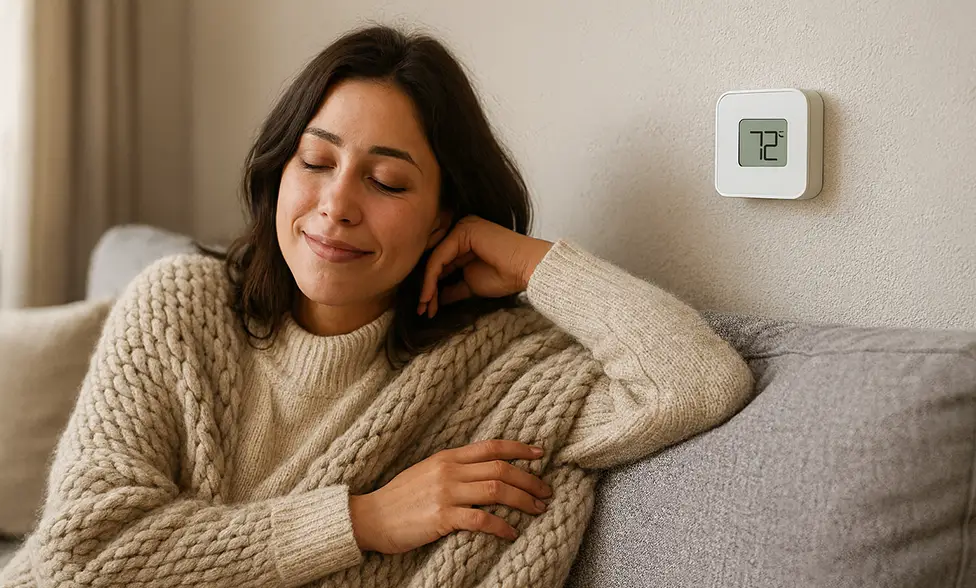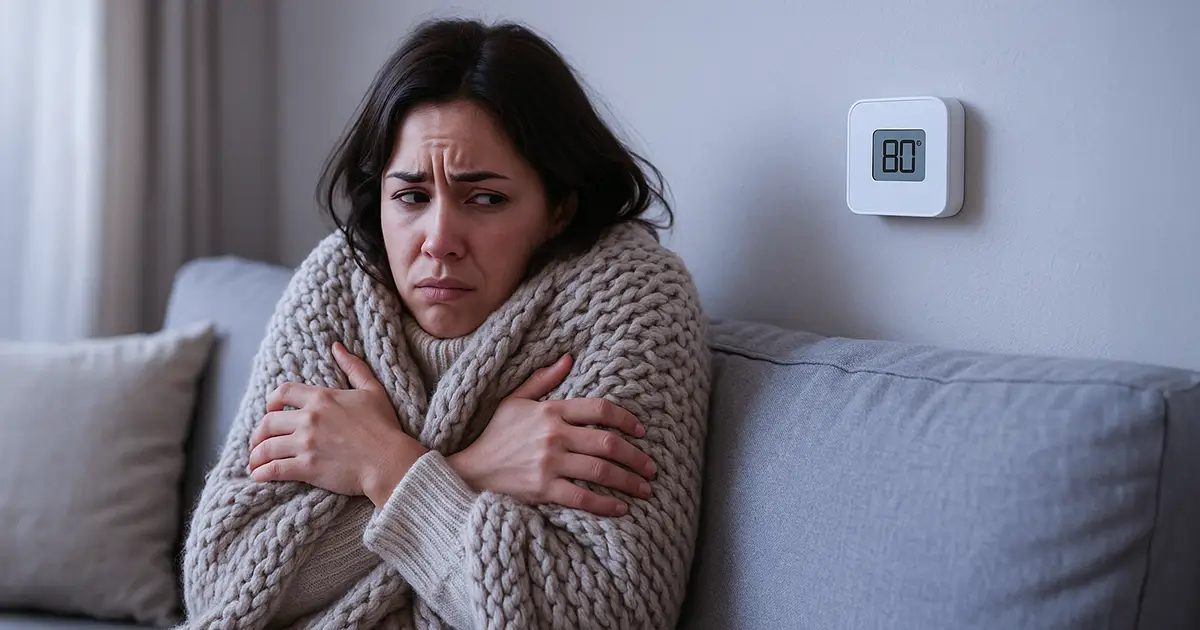Fall weather keeps us guessing. One day you’re opening windows, the next you’re reaching for the thermostat. It’s also when most homeowners make costly mistakes with their heating systems without even realizing it.
These seemingly harmless habits quietly drive up your energy bills, reduce comfort, and put unnecessary wear on your HVAC system. The good news? Brad is here with a few simple fixes that can save you money all season long.
#1: Cranking the Heat to Warm Up Faster
Walk into a cold room and your first instinct might be to push the thermostat to 78°F, thinking it’ll heat up quicker. It won’t.
Here’s why: your thermostat doesn’t control heating speed. It only sets the target temperature. Whether you choose 70°F or 78°F, your furnace runs at the same pace. The only difference is how long it stays on. Cranking it higher just leads to an overheated home and wasted energy.
The fix: Set your desired temperature and let the system do its job. If you want your home warm when you arrive, a smart thermostat can start heating before you get there.
#2: Setting One Temperature All Day Long
Fall temperatures swing wildly between warm afternoons and chilly mornings. Many people respond by picking one thermostat setting and leaving it there all day. This “set it and forget it” approach seems convenient, but it’s rarely efficient.
Heating an empty home or maintaining the same temperature while everyone sleeps wastes significant energy.
The fix: Use a programmable or smart thermostat to lower the temperature when you’re away or sleeping, then raise it before you wake up or return home. This strategy cuts energy costs without sacrificing comfort, especially during Fall’s unpredictable weather.
#3: Using Deep Setbacks With the Wrong System
Lowering your thermostat at night or when you’re away sounds smart. But not all HVAC systems handle temperature setbacks efficiently.
If you have a heat pump with auxiliary electric resistance heat, a deep setback might trigger that expensive backup system during recovery. Instead of saving money, you’ll spend more. Oversized systems or undersized equipment can also struggle, leaving you uncomfortable on cold mornings.
The fix: Start with a modest setback of just 2-3 degrees and monitor how your system responds. If it recovers smoothly, you can experiment with slightly larger adjustments. When in doubt, conservative setbacks work best.
#4: Placing Your Thermostat in the Wrong Spot
Your thermostat only knows what it can sense. When it’s placed near heat sources like ovens, sunny windows, or electronics, it thinks your whole house is warmer than it actually is. The result? Shorter heating cycles and cold rooms.
The opposite problem happens when thermostats are in drafty hallways or unusually cold spots. They’ll overcompensate and run your system longer than necessary.
The fix: Install your thermostat on an interior wall in a frequently used room, about five feet above the floor. This gives it the most accurate reading of your home’s actual temperature.
#5: Trying to Control Humidity by Lowering the Temperature
Fall humidity can still be an issue, especially in humid climates. When your home feels muggy, you might lower the thermostat, hoping cooler air will help. It might make you feel less sticky temporarily, but it doesn’t solve the problem.
Cool air plus high humidity creates a cold, damp feeling instead of cozy comfort. It can also increase condensation and mold risk.
The fix: Use a dehumidifier or check that your HVAC fan isn’t circulating moist air unnecessarily. Address humidity directly rather than fighting it with temperature changes.
#6: Leaving Your Fan on “On” Instead of “Auto”
Many thermostats let you run the fan continuously, even when heating or cooling is off. This seems like a good way to keep air circulating during those in-between Fall days.
But here’s the problem: after your AC shuts off, the fan keeps blowing air over the wet evaporator coil. That moisture evaporates back into your home, raising indoor humidity levels.
The fix: Keep your fan set to “Auto” so it only runs when heating or cooling is active. The exception is if you’re using specific air filtration systems that require continuous airflow.
#7: Misusing “Emergency Heat” on Heat Pumps
When temperatures hit the 40s, many heat pump owners wonder if they should switch to “Emergency Heat.” Maybe you’ve heard heat pumps don’t work well in cold weather, or your home just feels chillier than you’d like.
But “Emergency Heat” isn’t for regular use. It bypasses your heat pump entirely and runs expensive electric resistance heat instead. Unless your heat pump has actually failed, this setting should stay off.
The fix: Let your system work as designed. Modern heat pumps operate effectively even in cold temperatures, down into the teens. They’ll activate auxiliary heat automatically only when truly needed.
#8: Skipping Basic Thermostat Maintenance
A thermostat that looks fine on the wall might not be performing accurately. Dust buildup throws off temperature readings. Low batteries cause random resets or signal loss. Miscalibration leads to comfort issues and unnecessary runtime.
The fix: Check your thermostat’s calibration this Fall. Tape a room thermometer nearby and compare readings after an hour. If there’s more than a one-degree difference, clean the unit or replace the batteries. If problems continue, consider professional calibration or replacement, especially for thermostats over ten years old.
#9: Sticking With an Outdated Thermostat
If you’re still using a manual or basic digital thermostat, you’re leaving money on the table. Smart thermostats eliminate guesswork by learning your routine and automatically adjusting for maximum efficiency.
They adapt based on your location, weather forecasts, and even real-time energy rates depending on your utility provider. Most homeowners see energy savings of 8-10% annually, and the devices typically pay for themselves within one to two years.
The fix: Upgrade to a smart thermostat this Fall. It’s one of the easiest ways to reduce heating costs without thinking about it.
#10: Heating the Room When You Should Heat Yourself
You don’t always need to touch the thermostat. A sweater or throw blanket can boost your comfort by several degrees. Lowering your thermostat by just 2°F in winter can cut your heating bill by up to 10%.
During Fall, when one layer makes the difference between cold and comfortable, dress warmly and keep the thermostat modest. Save the high heat for true winter weather.
The fix: Make personal warmth adjustments before reaching for the thermostat. Your wallet will thank you.

Final Thoughts
If your energy costs spike every Fall or your home never feels quite right, your thermostat habits might be the culprit. Small changes now can make a big difference when the cold really sets in.
Need help optimizing your thermostat settings or upgrading to a smart system before winter arrives? Brad is more than happy to help! Give him a call today at (501) 330-8066. He’ll make sure you stay warm, comfortable, and efficient all season long without breaking the bank.






